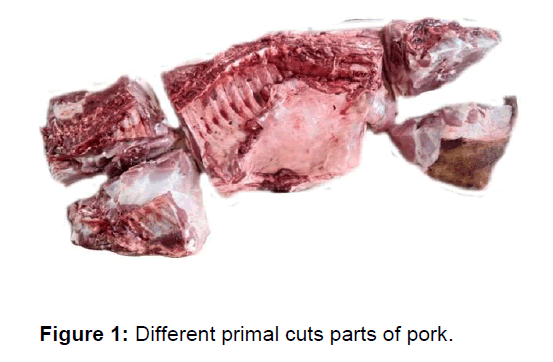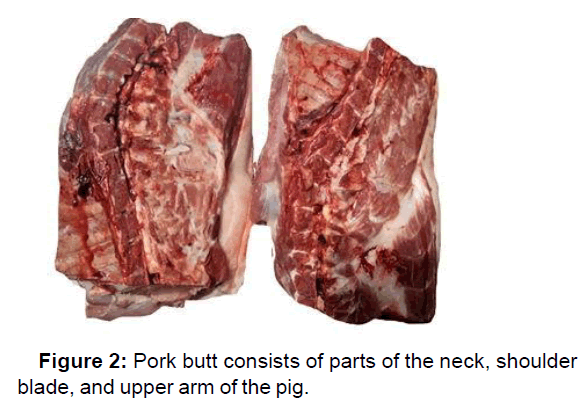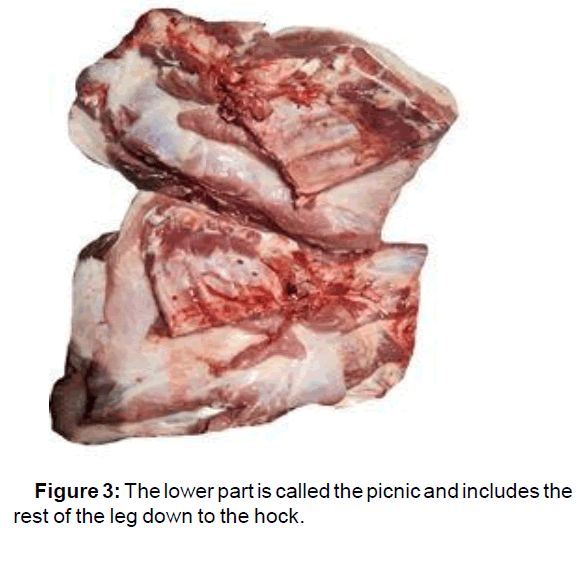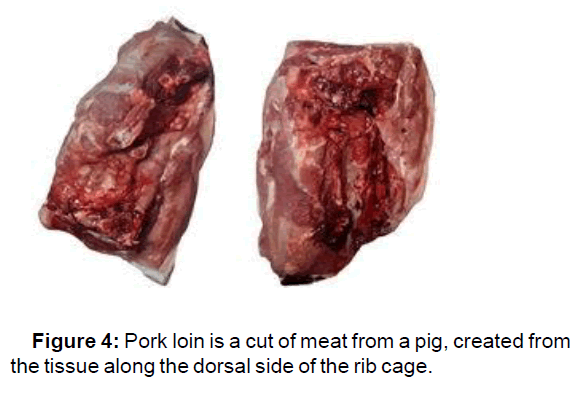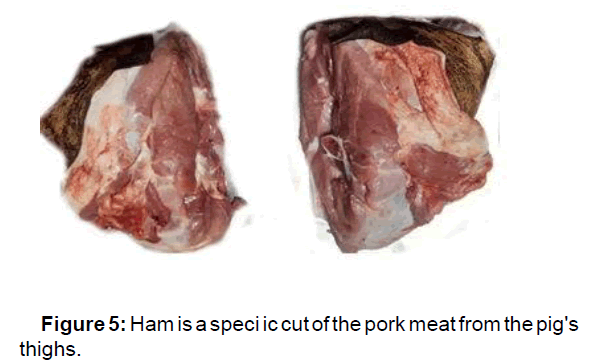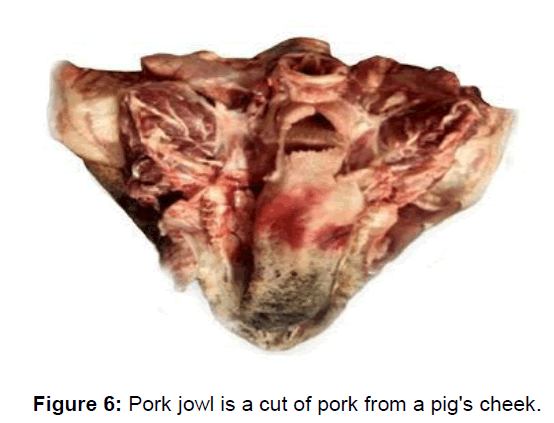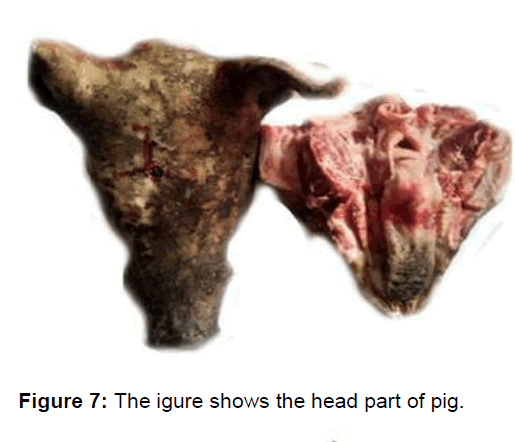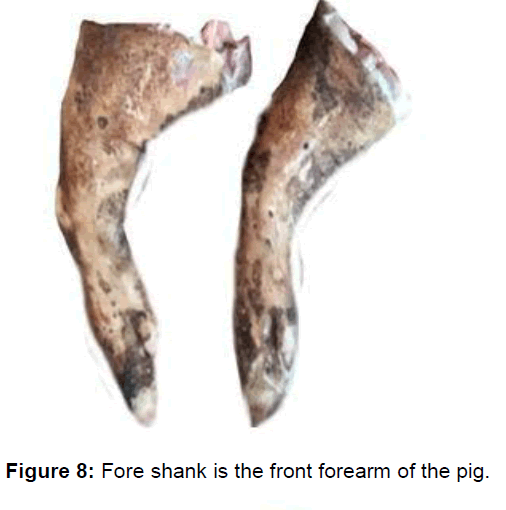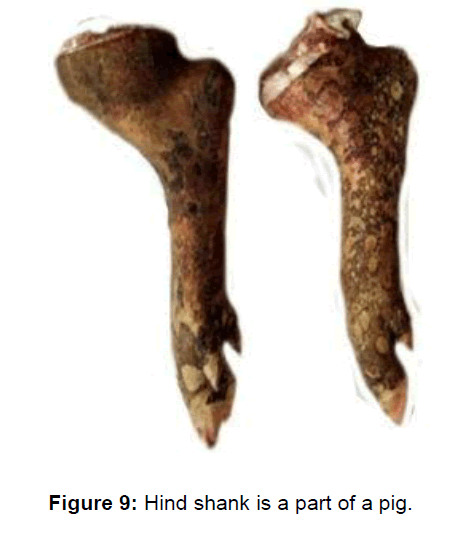Keywords
Large White Yorkshire (LWY); Castration; KMnO;
Boar taint
Introduction
Castration in the pig is performed to decrease the boar taint
upon cooking of pork in males which is an unpleasant odor. The
intensity of boar taint is directly proportional to the age of the
animal at slaughter in uncastrated male pigs by Rydhmer et al.,
[1].
Besides, the soiling of certain body parts with pig excrement
at the head and abdomen were found to have a signi icant effect
on the level of the androstenone and skatole leading to boar
taint in the meat by Thomsen et al., [2].
One method of inhibiting sexual development and boar
taint is immunization against Gonadotropin-Releasing Factor
(GnRF) by Bonneau et al., or by chemical methods [3].
Therefore, this study aimed to understand certain carcass
characteristics of pigs under the non-surgical mode of
castrations using KMnO4 and AgNO3.
Materials and Methods
A total of 24 Large White Yorkshire (LWY) of male pigs of 2-3
months age were selected for this experiment. All the pigs were
fed as per the NRC 1998 standard of feeding regimen for
growing/finisher pigs and the experiment was conducted from
winter to monsoon (November to June), 2018 to 2019. The pigs
were allocated into three different group’s viz. T1, T2, and
control consisting of 8 pigs per group.
The tested animals were managed following the Committee
for the Purpose of Control and Supervision of Experiments on
Animals (CPCSEA) and the experiment was approved by the
Institutional Animal Ethics Committee (IAEC) at the College of
Veterinary Sciences and Animal Husbandry, Mizoram, India.
The first group or control (C) was surgically castrated under
local anesthesia, with all the necessary post-operative
treatment. Pigs in the second group or treatment one (T1), were
subjected to chemical castration using 5% silver nitrate solution
which was injected@a dose of 2 ml intra-testicular/testes. Pigs
in the third group or treatment two (T2) were subjected to
chemical castration using 0.25% (250 mg potassium
permanganate in 17 ml glacial acetic acid and 83 ml sterile
distilled water). These solutions were injected@a dose of 2 ml
intra-testicular/testes.
For T1 and T2, the prepared solution was injected using 24-
gauge needle syringes. The needle was inserted into the testes
from the caudal end of the testes to the caput of the testes. The
solution was injected into the testes while withdrawing the
syringe from the testes, so that maximum solution was injected
into the whole of the testes. For comparison and statistical
analysis, the surgically castrated group (C) was taken as control
and was compared with the two groups of T1 and T2
respectively.
At the end of the experiment i.e. after 6 months three pigs
from each group were slaughtered to study the Carcass Weight
(kg), Butt (kg), Backfat thickness (cm), Dressing Percentage (%),
and sensory evaluation.
Results and Discussion
The mean ± SE of pre-slaughter weight (kg), carcass weight
(kg), butt (kg), backfat thickness (cm), and dressing percentage
(%) of LWY male pigs at 8 months of age are presented in Table 1
| Characteristics |
Treatment group |
| C |
T1 |
T2 |
f value |
p Value |
| Live Weight (kg) |
98.00 ± 1.04b |
102.67 ± 0.67a |
97.00 ± 1.50b |
7.43* |
0.02 |
| Carcass Weight(kg) |
69.17 ± 0.73a |
74.67 ± 0.60b |
70.33 ± 1.09a |
12.09** |
0.01 |
| Head(kg) |
7.60 ± 0.10 |
7.10 ± 0.56 |
6.27 ± 0.37 |
2.97 NS |
0.13 |
| Fore shank(kg) |
2.47 ± 0.03 |
2.67 ± 0.17 |
2.50 ± 0.01 |
1.19 NS |
0.37 |
| Hind Shank(kg) |
3.17 ± 0.56 |
2.60 ± 0.10 |
3.60 ± 0.85 |
2.11 NS |
0.2 |
| Pluck(kg) |
13.83 ± 1.36 |
14.67 ± 1.74 |
12.83 ± 0.44 |
0.50 NS |
0.63 |
| Ham(kg) |
16.87 ± 0.33 |
17.83 ± 0.17 |
16.67 ± 0.58 |
1.14 NS |
0.31 |
| Loin(kg) |
16.89 ± 0.17 |
17.17 ± 0.44 |
16.50 ± 0.50 |
0.94NS |
0.44 |
| Picnic(kg) |
17.17 ± 0.27 |
18.17 ± 0.33 |
16.33 ± 0.60 |
0.04NS |
0.96 |
| Butt(kg) |
18.36 ± 0.33b |
20.17 ± 0.17a |
19.00 ± 0.60b |
51.80** |
0.001 |
| Jowl(kg) |
3.56 ± 0.17 |
4.00 ± 0.29 |
3.33 ± 0.44 |
1.46 NS |
0.31 |
| BFT(cm) |
4.13 ± 0.09b |
2.57 ± 0.19a |
2.90 ± 0.10a |
39.13** |
0.001 |
| Dressing (%) |
70.58 ± 0.10a |
72.73 ± 0.16b |
72.51 ± 0.01b |
30.33** |
0.001 |
(*) Significant (P ≤ 0.05), (**) Significant (P ≤ 0.01) and NS Non-significant
Note: Means bearing at least one common superscript in each row do not differ significantly.
Table 1: Mean Characteristics of meat between the different
treatments.
The mean ± SE of the sensory attributes of meat in LWY male pigs at slaughter age of 8 months are presented in Table 2.
| Characteristics |
Treatment group |
| C |
T1 |
T2 |
f value |
| Appearance |
4.8 ± 0.64 |
4.8 ± 0.70 |
4.83 ± 0.70 |
0.840 NS |
| Flavour |
4.85 ± 0.95 |
4.8 ± 0.99 |
4.81 ± 0.95 |
0.962 NS |
| Texture |
4.2 ± 0.76 |
4.5 ± 0.70 |
4.25 ± 0.51 |
0.136 NS |
| Juiciness |
3.6 ± 0.73 |
3.7 ± 0.57 |
3.67 ± 0.57 |
0.854 NS |
| Presence of Taint |
5.95 ± 1.15 |
5.58 ± 1.04 |
6.25 ± 0.64 |
0.157 NS |
| Overall Acceptability |
5.7 ± 1.00 |
5.6 ± 1.63 |
5.95 ± 0.69 |
0.641NS |
(*) Significant (P ≤ 0.05), (**) Significant (P ≤ 0.01) and NS Non-significant
Note: Means bearing at least one common superscript in each row do not differ significantly.
Table 2: Mean sensory evaluation of meat between the
different treatments.
The mean live weight (kg) of pigs under T1, T2, and C groups at the end of the experiment were 102.67 ± 0.67, 97.00 ± 1.50&98.00 ± 1.04 kg respectively. Statistical analysis revealed that the live weight of T1 at the end of the experimental study (i.e. at 180 days) was significantly higher (P<0.01) than T2 and C
groups. The higher pre-slaughter weight may be due to better FCE in T1 when compared to T2 and C groups.
The carcass weight of pigs under the T1, T2, and C groups were 74.67 ± 0.60, 70.33 ± 1.09&69.17 ± 0.73 kg respectively after evisceration and exsanguination. The highly significant
difference in the carcass weight of T1 may be due to the fact that animals in this group showed a highly significant weight of
butt than the T2 and C. Moreover, during the experimental studies, it was found that the T1 group was having a better performance in terms of the weight of the different cut parts i.e.
ham, loin, picnic, and jowl when compared to the T2 and C group but the difference was found to be non-significant as shown in Figure 1- 6. Similar work had also been reported by
Gispert et al., Serrano et al., Zamaratskaia et al., and Oliver et
al., of higher carcass weight under immune-castration [4-7].
Figure 1: Different primal cuts parts of pork.
Figure 2: Pork butt consists of parts of the neck, shoulder blade, and upper arm of the pig.
Figure 3: The lower part is called the picnic and includes the rest of the leg down to the hock.
Figure 4: Pork loin is a cut of meat from a pig, created from the tissue along the dorsal side of the rib cage.
Figure 5: Ham is a speci ic cut of the pork meat from the pig's thighs.
Figure 6: Pork jowl is a cut of pork from a pig's cheek.
The mean dressing percentage (%) of pigs under T1, T2, and C
groups were 70.58 ± 0.10, 72.73 ± 0.16, and 72.51 ± 0.01 %
respectively which was calculated out after recording the carcass weight and live weight. Statistical analysis shows a significantly lower dressing percentage in the C group (P<0.01) compared to
T1 and T2 groups.
The higher dressing percentage observed in chemical castration maybe because there was higher lean meat and lesser
BFT in these groups as show in Figure 7- 9. This may be due
to the increase in the testosterone hormones which
promotes protein metabolism which in turn led to an increase
in muscle mass and decreases the fat percent, which follows
the finding by Schanbacher, Pond and Bonneau et al., [8,9].
Figure 7: The igure shows the head part of pig.
Figure 8: Fore shank is the front forearm of the pig.
Figure 9: Hind shank is a part of a pig.
The BFT recorded in the study was comparable to the findings of Serrano et al., Latorre et al., Fahim and Bonneau et al., reporting that the BFT were lower than those of animals under surgical castration [5,9-11]. The present study reveals that the
measurements of BFT in chemically castrated animals (T1 and
T2) were significantly lower when compared to the surgically castrated group (C). The higher BFT in the C group may be due to
higher feed intake as the requirement of energy in surgically castrated pigs was more for decomposition of fats which subsequently and gradually deposited in the body by Balaji et
al., [12]. The lower BFT in the chemically castrated animals may be due to the increase in the amount of meat, subsequently reducing the amount of fat percentage.
From the present study statistical analysis revealed that there
was no significant difference in the sensory attributes of the meat among the treatment groups. Similar findings were also reported by Caldara et al., Zamaratskaia et al.,Dunshea et al., Meloen et al.,Fahim and Koger in which the animals were either castrated by immune-castration or by chemical castration
[6,11,13-18].
Conclusion
It may also be pointed out that the pigs castrated with
chemicals were found to have lower Dressing percentage and
Back Fat Thickness and higher Carcass weight and Pre- Slaughter
Weight when compared to the surgically castrated pigs. From
the present research work, it was also found that the taint odor
in the meat of the pork between the chemical castration and
surgical castration yield no significant difference. Concluding
that the chemical castration may also be effective in controlling
the boar taint.
References
- Rydhmer L, Lundstrom K, Andersson K (2010) Immunocrastration reduces aggressive and sexual behaviour in male pigs. Animal 4:965-972.
- Thomsen R, Edwards SA, Jensen BB, Rousing T, Sørensen JT (2015) Effect of faecal soiling on skatole and androstenone occurrence in organic entire male pigs. Animal 9:1587-1596.
- Bonneau M, Dufour R, Chouvet C, Roulet C,Squires EJ (1994) The effects of immunization against luteinizing hormone releasing hormone on performance, sexual development, and levels of boar taint-related compounds in intact male pigs. J Anim Sci 72:14-20.
- Gispert M, Oliver M À, Velarde A, Suarez P, Pérez J, et al (2010) Carcass and meat quality characteristics of immunocastrated male, surgically castrated male, entire male and female pigs. Meat Science 85:664-670.
- Serrano M P, Valencia D G, Fuentetaja A, Lázaro R, Mateos GG (2009) Effect of castration on productive performance, carcass characteristics and meat quality of Iberian pig females reared under intensive management systems. Livestock Science 123:147-153.
- Zamaratskaia G, Andersson H , Chen G (2008) Effect of Gonadotropin-releasing hormone (ImprovacTM) on steroid hormones, boar taint compounds and performance in entire male pigs. Reprod Domest Anim 43:351-359.
- Oliver WT, McCauley I, Harrell RJ, Suster D, Kerton DJ, et al (2003) A Gonadotropin-releasing factor vaccine (Improvac) and porcine somatotropin have synergistic and additive effects on growth performance in group-housed boars and gilts. J Anim Sci 81:1959-1966.
- Schanbacher BD, Yen JT, Pond WG (1985) Testosterone and the incidence of boar taint: Effects of testosterone or testosterone propionate on the incidence of boar taint in implanted barrows. Meat science 13:237-245.
- Bonneau M, Meadus WJ,Squires EJ (1992) Effects of exogenous porcine somatotropin on performance, testicular steroid production and fat levels of boar-taint-related compounds in young boars. Canadian J Anim Sci 72:537-545.
- Latorre MA, Lázaro R, Gracia M I, Nieto M, Mateos G G (2003) Effect of sex and terminal sire genotype on performance, carcass characteristics, and meat quality of pigs slaughtered at 117 kg body weight. Meat science 65:1369-1377.
- Fahim M S (1994) Chemical castration. United States Patent 5372822.
- Balaji N S, Sivaraman T, Sivakumar T, Ramesh V (2006) Influence of castration on growth rate and body measurements in Large White Yorkshire pig. Indian J Anim Res 40:123-126.
- Caldara F R, Moi M, dos Santos L S, Paz ICDLA, Garcia RG et al (2013) Carcass characteristics and qualitative attributes of pork from immunocastrated animals. Asian-Australas J Anim Sci 26:1630-1636.
- Dunshea F R, Colantoni C, Howard K, McCauley I, Jackson P et al (2001) Vaccination of boars with a GnRH vaccine (Improvac) eliminates boar taint and increases growth performance. J Anim Sci 79:2524-2535.
- Meloen R H, Turkstra JA, Lankhof H (1994) Efficient immuno-castration of male piglets by immunoneutralization of GnRH, using a new GnRH-like peptide. Vaccine 12:741-746.
- Koger LM, (1978) Calcium chloride castration. Mod Vet Pract 59:119-121.
- Konaka K, Uchiyama F, Yamada Y, Iso H (2003) A case of abomasal impaction diagnosed by analysis of electrolytes and blood gas in a cow. J Livestock Med 50: 851-854.
- National Research Council (1998) Nutrient Requirements of Swine.(10th edn),The national academic press, Califonia USA. Pp: 111.

